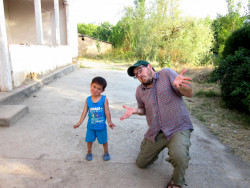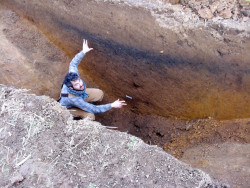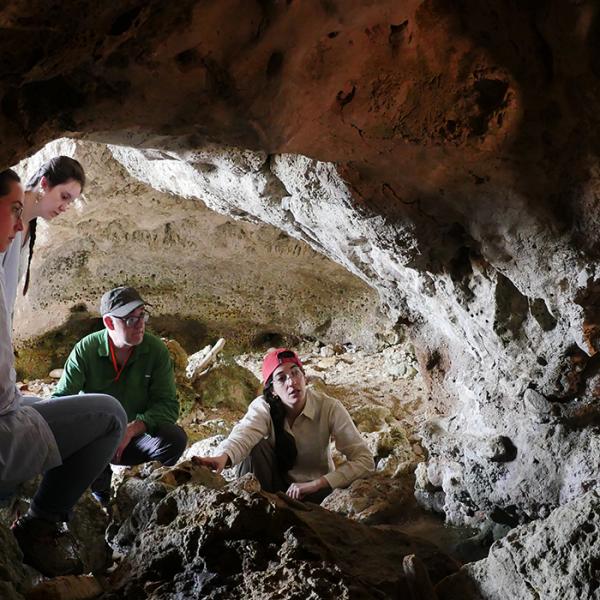Edward Henry is an archaeologist with the Department of Anthropology at Washington University in St. Louis. His research explores major shifts in the structure of social, economic, and political organization. Specifically, he is interested in the transformation of both ritual/religious and economic structures as complex hunter-gatherers transition to a heavier reliance on domesticated food production.
He is currently working on his dissertation, “Building Local Chronologies for Middle Woodland-era Earthen Enclosures in the Middle Ohio Valley: A Perspective from Kentucky’s Bluegrass Landscape”. As he nears the end of his dissertation writing, we wanted to find out how he chose a path in archaeology.
How did you get started with anthropology?
 I was first introduced to anthropology while pursuing an undergraduate major in Secondary Education at the University of Kentucky. This major required me to take classes that would develop my capacity to teach subjects common to high schools across the country. I focused on history, but I also needed a minor. Because I was interested in the historical aspects of social change (e.g., conflict, economics, technology) my undergraduate advisor suggested I take a cultural anthropology class. My life was forever changed by this decision. In my introductory class I remember reading Philippe Bourgois’ In Search of Respect: Selling Crack in El Barrio. I was amazed at how ethnographic descriptions could inform our understandings of society within particular historical and cultural contexts. That class peaked interests in what anthropology had to say about history, and more specifically, inequality.
I was first introduced to anthropology while pursuing an undergraduate major in Secondary Education at the University of Kentucky. This major required me to take classes that would develop my capacity to teach subjects common to high schools across the country. I focused on history, but I also needed a minor. Because I was interested in the historical aspects of social change (e.g., conflict, economics, technology) my undergraduate advisor suggested I take a cultural anthropology class. My life was forever changed by this decision. In my introductory class I remember reading Philippe Bourgois’ In Search of Respect: Selling Crack in El Barrio. I was amazed at how ethnographic descriptions could inform our understandings of society within particular historical and cultural contexts. That class peaked interests in what anthropology had to say about history, and more specifically, inequality. What steered you to archaeology?
 When I took my first archaeology class, a Ph.D. candidate visited to describe his research on costal hunter-gatherers and an archaeological fieldschool he was directing on an island off the coast of Georgia only accessible via a 30-minute ferry ride. He said the eight weeks of hands-on learning (i.e., manual labor) would be intense—requiring students to stay in tents and begin working around 7am everyday. But something else in his description of this field experience caught my attention: work would end everyday by 3:30 in the afternoon at which time students could spend the rest of the day at the beach! I quickly agreed with a good friend sitting behind me that this would be how we spent our upcoming summer. My first field experience taught me how to excavate and exposed me to geophysical methods that allowed one to “dig digitally”. After this experience I knew that archaeology would be a way that I could fuse many of my interests: history, anthropology, and the outdoors.
When I took my first archaeology class, a Ph.D. candidate visited to describe his research on costal hunter-gatherers and an archaeological fieldschool he was directing on an island off the coast of Georgia only accessible via a 30-minute ferry ride. He said the eight weeks of hands-on learning (i.e., manual labor) would be intense—requiring students to stay in tents and begin working around 7am everyday. But something else in his description of this field experience caught my attention: work would end everyday by 3:30 in the afternoon at which time students could spend the rest of the day at the beach! I quickly agreed with a good friend sitting behind me that this would be how we spent our upcoming summer. My first field experience taught me how to excavate and exposed me to geophysical methods that allowed one to “dig digitally”. After this experience I knew that archaeology would be a way that I could fuse many of my interests: history, anthropology, and the outdoors. What is your dissertation research focused on?
Most recent publications
2017. Henry, Edward R., Bill Angelbeck, and Uzma Z. Rizvi. Against Typology: A Critical Approach to Archaeological Order. The SAA Archaeological Record 17(1). In Press.
2017. Henry, Edward R., W. Stephen McBride, and Philip B. Mink. Anthropologically Focused Geophysical Survey and Public Archaeology: Engaging Present-day Agents in Placemaking. In Archaeological Remote Sensing in North America: Anthropological Applications Using Innovative Technologies, edited by Duncan P. McKinnon and Bryan S. Haley. University of Alabama Press, Tuscaloosa. In Press.
2017. Henry, Edward R., Anthony L. Ortmann, Lee J. Arco, and Tristram R. Kidder. Tetrahedron Baked-Clay Objects from an Early Woodland Context at the Jaketown Site, Mississippi. Southeastern Archaeology 35(1) DOI: 10.1080/0734578X.2016.1223498
2016. Henry, Edward R., and Casey R. Barrier. The Organization of Dissonance in Adena-Hopewell Societies of Eastern North America. World Archaeology 48(1): 87–109.


